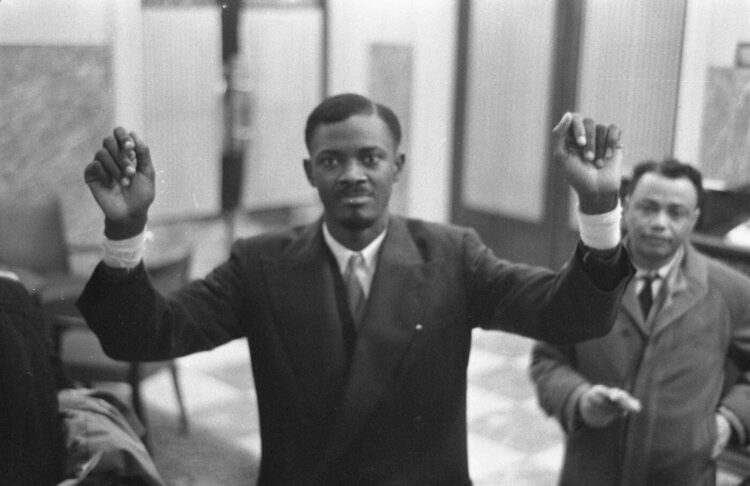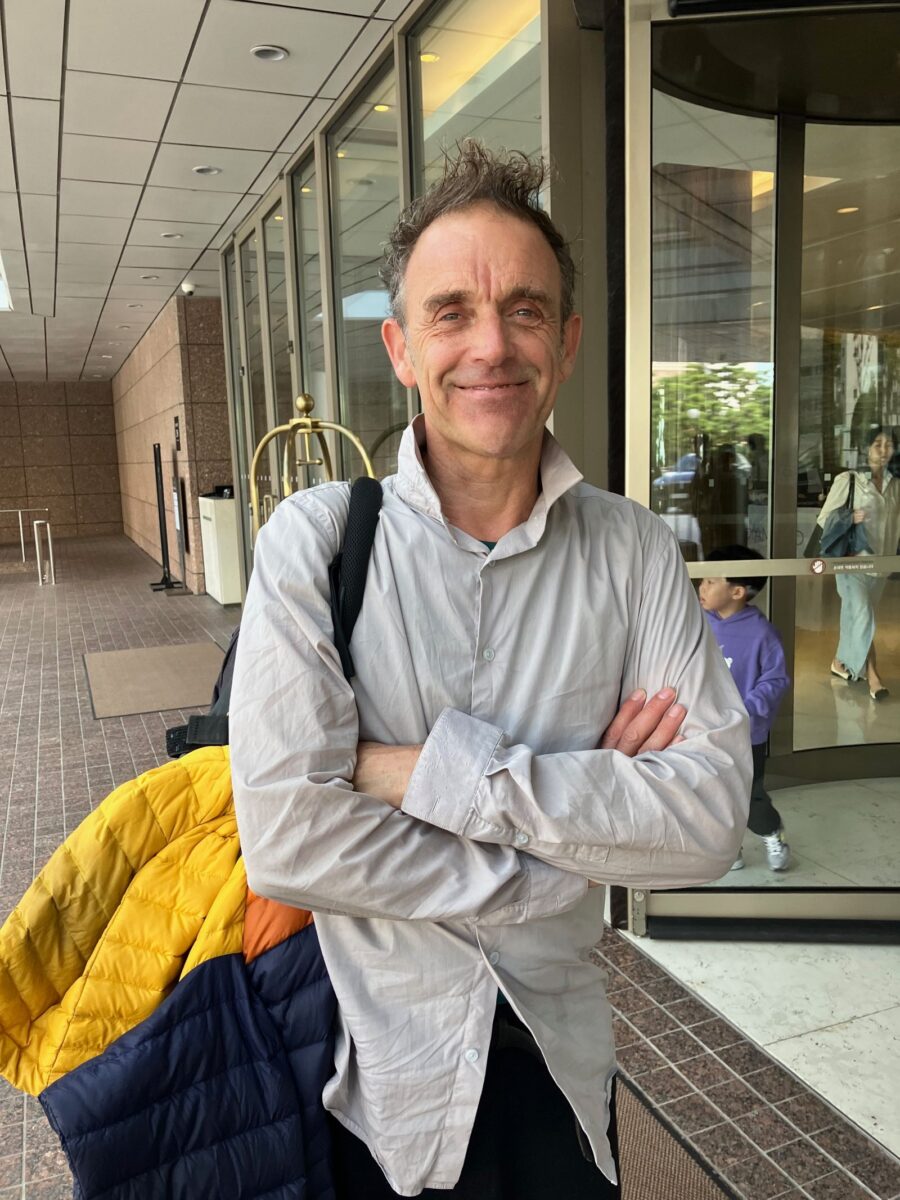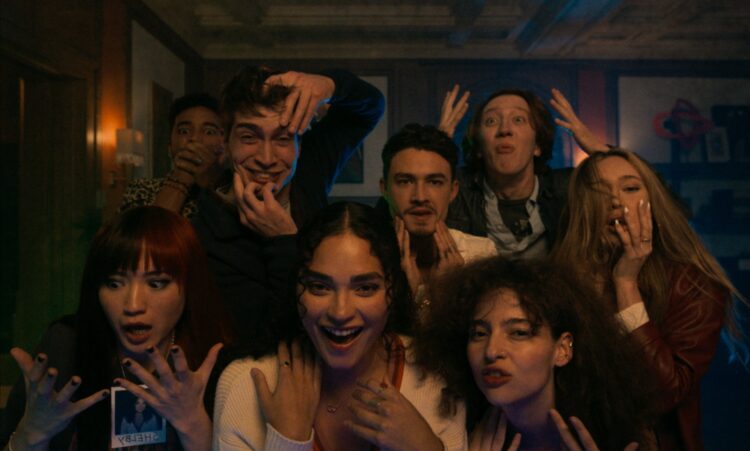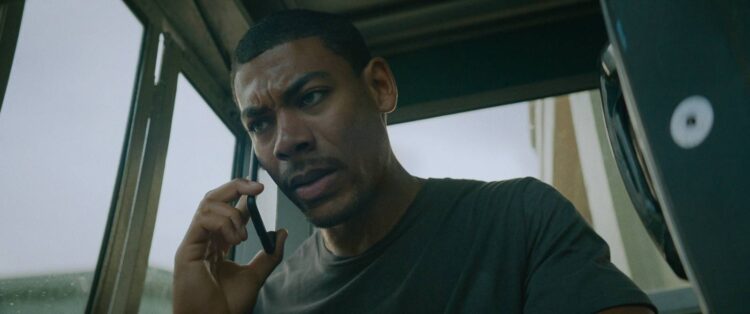

An artist and writer as well as documentary filmmaker, Johan Grimonprez takes a multidisciplinary approach to his subjects, combining archival footage, interviews, and cultural artifacts to dismantle how history is shaped and presented to us. As French writer Voltaire writes: “History is the lie commonly agreed upon”
Centered around the assassination of Congo leader Patrice Lumumba in 1961, Soundtrack to a Coup d’Etat is a kaleidoscope of politicians, spies, colonialism, revolution, and music––specifically jazz music of the 1950s and 1960s. Weaving together strands from Africa, Europe, and the United States, Grimonprez makes a compelling case that Lumumba’s death reverberates through society to this day.
Grimonprez uses jazz as a thread to tie together stories as disparate as Russian leader Nikita Khrushchev pounding his shoe at the United Nations, the CIA sponsoring “jazz ambassador” tours of Africa, and Belgian leaders holding onto Congolese resources while ceding control of the country.
In jazz, a musician transforms a song’s melody by reinterpreting its structure, extending or shortening passages, adding outside references, either following or breaking rules until the song gains a new identity. Grimonprez’s use of concert footage, newsreels, and advertising ephemera works similarly, offering a new way to define the events and people who still affect our lives.
We met at the bar of the Paradise Hotel in Busan, where tinkly piano music threatened to drown out our conversation. Grimonprez was screening Soundtrack at the Busan International Film Festival prior to bringing his doc to U.S. theaters from Kino Lorber, beginning at Film Forum in New York this Friday.
The Film Stage: Congratulations on this documentary. It’s a massive achievement. When did you decide on the central conceit of using jazz music?
Johan Grimonprez: This story has been growing on me since Double Take (2009), where Nikita Khrushchev becomes Alfred Hitchcock’s doppelganger. I knew about Khrushchev’s shoe-banging, but I didn’t know that it actually had to do with my country, Belgium, and its relationship to Congo. Things fell into place when I started Shadow World (2016), which is about the defense industry. Finding out how the United States wheels and deals weaponry––more than the whole world combined does––made me want to dig into the backyard of my country, Belgium.
Lumumba is still considered a villain by many in Belgium. When he rose to power, Belgian politicians labeled him a Communist because they knew it would draw the United States to their side. They dragged the CIA into the revolution in part so they could retain control over Union Minière, a crucial source of copper and uranium. Ludo De De Witte, who wrote The Assassination of Patrice Lumumba, helped open up the UN archives. His book was one of the reasons why a parliamentary commission was formed to investigate what really happened to Lumumba.
But why jazz music? How did that help you explain this story?
I knew that Louis Armstrong was there during the overthrow of Lumumba, but I didn’t know all the details. I found out that he was sent there as a “jazz ambassador,” even as Lumumba’s assassination was being plotted. Then there were the musicians and artists who crashed the UN Security Council meeting about Congo where they officially announced the murder of Patrice Lumumba. Abbey Lincoln, Max Roach, Maya Angelou, and others disrupted the session. That led me to We Insist! [aka Max Roach’s Freedom Now Suite], an album about the civil rights struggle in the U.S. that Roach expanded to include songs about conditions in Africa.
I want to add that Armstrong was not this propaganda tool; he wasn’t this passive instrument. During the African tour, he refused to play for apartheid audiences in South Africa.
You include him performing Fats Waller’s “Black and Blue,” a remarkably revolutionary song from 1929.
A very subtle thing that surprised me was that, during the tour, he changed the lyrics from “I’m white inside” to “I’m right inside.”
It’s interesting the musicians you chose not to include.
Sometimes it was the rights. Like, we couldn’t get the rights for Charles Mingus. We circumvented that by using Eric Dolphy. Going back to We Insist!, they recorded a concert that was broadcast in its entirety on Belgian television––at the same moment of the genocide in Congo. I found it in the archives. I found that juxtaposition chilling. I love the fact that we can layer things. There’s a sort of horizontal timeline, but then we can stack things vertically as well, opening the cinematic third space.
Also, we have a different relationship to jazz in Belgium, in Europe as a whole. Miles Davis living in Paris is very different situation than Miles Davis living in the United States. The music here is not just a soundtrack. As protagonists, these songs are also historical agents. We chose John Coltrane’s “Alabama” because that was happening when Malcolm X was giving his speech about pilots bombing freedom fighters in Congo.

Johan Grimonprez at Busan International Film Festival
Songs operate because an authority (i.e., the songwriter) has set up a structure and a set of rules for following that structure (keys, timing, etc.). Jazz musicians can follow those rules or break them or ignore them. Monk, for example, played with timing, with the actual notes of a song, changing them to what he wanted. “Wrong is right,” he said, “there are no wrong notes.” I wonder whether you found yourself using those same improvisatory, rule-breaking methods in your doc. Whether jazz music gave you the freedom or inspiration to explore themes, take digressions, comment on material.
I had to think of Fumi Okiji’s Jazz as Critique, where she writes about syncopation, about the note being indeed wrong or off, and she links it to the conflicted Black subject. Jazz gives us access to this double consciousness of displaced Blackness––a gathering of contradictions of living next to your identity and the outside world, the uprootedness of living in contradiction, as Ornette Coleman alludes to in the film––the heterophonic chorus of unacknowledged othering, in chronic homelessness.
We haven’t spoken about this wide cast of characters you include, like William A.M. Burden––an ambassador to Belgium, a spy with the CIA, and on the board of directors of the Museum of Modern Art.
We found Burden’s audio interview at the Department for Diplomatic Studies at Columbia University; it had never been released before. I was amazed at how forthright he was about what was going on in Congo, literally conceding during this recording that the assassination of Patrice Lumumba was the right thing to pursue.
In the U.S. we think of Khrushchev as a villain, and UN Secretary-General Dag Hammarskjöld as a hero. You flip that around here.
I like to tell a story from the position of the villain. Hitchcock used to say, “The more articulate and elegant the villain is, the more the hero has to work.” It’s more interesting when a doppelganger can sort of hold up a mirror. These guys were not saints, you know. We mention in the film Hammarskjöld’s role in the suppression of the Hungarian uprising.
Hammarskjöld was a complex personality, as his character arc throughout the film attests. He went on a rescue mission to China when John Foster Dulles warned him not to go. His “quiet diplomacy” was effective during the Suez Canal crisis. And ultimately he argued that all countries needed to be decolonized. But during the Congo mission he actually was complicit with the downfall of Lumumba.
What is your process for assembling material?
We’re still in the red, struggling to complete within the budget. I have a lot of interns and students who are willing to get involved. We relied on the UN archives. We gave them keyword search requests, and then wider requests––like everything from the 20th of September to the 13th of October, 1961. We asked for all of it, people arriving, ambassadors picking their nose, falling asleep, yawning.
I knew Khrushchev gave 10 big speeches, so we went through all of them. A student translated them for me. Then we had an entire set of cassette tapes digitized, audio recordings by Khrushchev in his dacha after he was overthrown by Brezhnev in 1964. His late son, Sergei, also allowed us to use his home movies. We tell Lumumba’s story through his associate Andrée Blouin. Her daughter, Eve-Sylviane, allowed us to use her home movies. The same with the novelist In Koli Jean Bofane, who let us use home movies of his stepfather. He has a very ambivalent relationship to that footage.
Seeing those home movies, the contradiction between these intimate stories making palpable the global political context in the General Assembly––seeing how people were affected––was the most surprising element of this for me. We also got stunning footage from Alexander Markov, a Russian filmmaker who’s in touch with cinematographers who were actually in Congo. And of course there’s the African Museum [Koninklijk Museum voor Midden-Afrika], where a dying race of colonials donated footage. We got some beautiful shots of Congo.
Editing this must have been a nightmare.
It took four years. That is when the writing occurs as well. We had many, many, many versions, including a four-hour cut. We had a wonderful scene with Paul Robeson, but we didn’t have room for what was essentially a subplot.
I had a treatment, because you need one to apply for funding. But it was just a point of departure, because as you’re editing you stumble across these little pearls. When someone sends us home movies, you incorporate them into your rewriting. The whole idea of conflict minerals used in iPhones and Teslas––that thinking happens in the editing.
I’m trying to provide a kind of kaleidoscopic point of view––unlike, for example, Adam Curtis’s work. There isn’t this godlike voiceover that imposes a narration. I’m adamant about listening to what the material has to offer, what the poetry of the images gives to open up a third space to juxtapose the contradictions. One cannot underestimate the viewer, who has become so media-savvy.
Showing footage of iPhone ads tells us that these problems haven’t been solved.
I feel that most of the debates about politics are just decoys. They screen the fact that a corporate plutocracy is actually holding the purse strings.
Soundtrack to a Coup d’Etat opens on Friday, November 1.
The post Soundtrack to a Coup d’Etat Director Johan Grimonprez on a Jazz-Fueled, Kaleidoscopic Vision of Displaced Blackness first appeared on The Film Stage.



